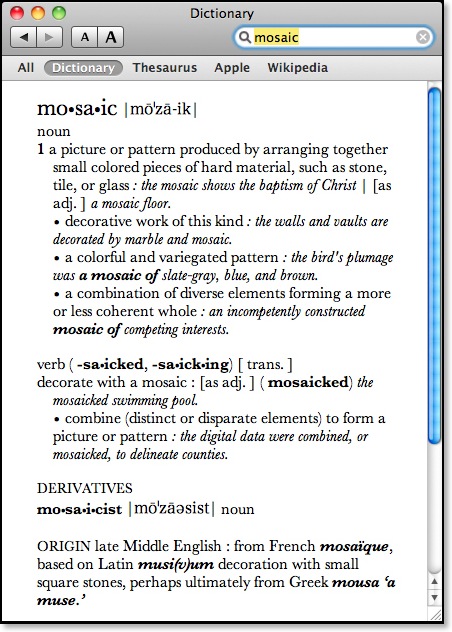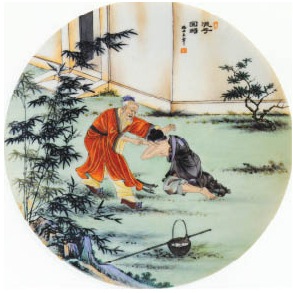Review: Holy Bible: Mosaic (NLT)
 Thursday, September 24, 2009 at 12:01AM
Thursday, September 24, 2009 at 12:01AM Stop #3 on Tyndale House's Holy Bible: Mosaic Blog Tour Long ago, the body of Christ recognized that the Canon of Scripture is closed. Thus, no matter how inspiring a Christian voice can be—such as Martin Luther King Jr. in "Letter from a Birmingham Jail"—we don't tack that on in our Bibles somewhere after the Book of Revelation. I understand that. But at the same time many contemporary Christians completely miss out on the voices of other believers from the past two millennia since the Bible was written. Often this comes from simply not having an easy way to access them.
Long ago, the body of Christ recognized that the Canon of Scripture is closed. Thus, no matter how inspiring a Christian voice can be—such as Martin Luther King Jr. in "Letter from a Birmingham Jail"—we don't tack that on in our Bibles somewhere after the Book of Revelation. I understand that. But at the same time many contemporary Christians completely miss out on the voices of other believers from the past two millennia since the Bible was written. Often this comes from simply not having an easy way to access them.
I'm sometimes guilty of such "chronological snobbery" myself. When preparing to teach a passage from the Bible, I tend to only look at articles, reference works, and commentaries written in the last fifty years of so—if even back that far. I mean, surely contemporary writers have consulted previous thought, right? Well, probably not. And I don't want to say I dismiss the past. I regularly read from historical Christian voices for other purposes—sometimes curiosity, sometimes for devotional purposes and always with a deep respect. But the average believer in my circles tends not even to do this. And for many of my peers, one might think that Christendom didn't really begin until the Reformation.
So now, along comes Holy Bible: Mosaic from Tyndale House Publishers (already most seem to be referring to this Bible as "the Mosaic Bible" or "Mosaic NLT." I'll probably do the same). The title of this Bible comes from the definition of a mosaic itself. As described in the "Mosaic User's Guide:
Mosaics are curious things. Bits and pieces of stone and glass that on their own may be interesting, but only fleetingly so. Together, however, those pieces form images that move us in unexpected and profound ways. From the simplest forms to the most complex, it is the combined effect of tiles arranged in their diversity that brings about something much greater than the sum of its parts. ... But as Christians, we are part of something much larger than simply the here and now. We are part of a mosaic—a patchwork of people, places, times, and cultures—that depicts one person: Jesus Christ. ... The purpose of this Bible is to provide a way to encounter Christ on every continent and in every century of Christian history. ... [Y]ou will find an extensive block of weekly meditations that draw on the collective wisdom of the global church across two thousand years of history, which will engage your heart and mind and guide you back into God's life-changing word.
And that's what the Mosaic Bible does: it incorporates Christian voices from two thousand years of history and from all over the world. These voices are collected into a series of readings that are organized around the Christian year. Now, I'll admit up front, that growing up in Southern Baptist churches, I've never formally celebrated the Christian year in any meaningful way. When Kathy and I moved to Kentucky, I noticed that many of the Baptist churches recognized Advent, and a small few observed Lent, but most did not. In fact, I only observed Lent—in a very clumsy way, miind you—for the first time this past year. But as I've grown older, as I've learned more about Christian history, I've had more desire to engage myself with many of the Christian traditions of ages past—and those traditions that many Christians still observed today. I don't think that's "non-Baptist" of me. What I do think is that often in an attempt to emphasize God's grace over the church's traditions, we've been guilty of throwing the baby out with the bathwater. Traditions can be very healthy. They can help ground us and give meaning for the days as we express our faith.
The Mosaic Bible is divided into two sections. The first contains a year's worth of readings and reflections around the Christian year. These aren't "daily" readings, although they could certainly be broken up into that. Rather, they are readings for the week to keep one focused on Christ. It's interesting to me that these readings are held in a separate section from the biblical text. But really, this is a good idea. It separates them from holy Scripture so that no one might be confused as to what is God's word and what is from human thought. The readings are printed on a cream colored paper and include color images of Christian art from ancient mosaics to modern treatments. Just as the readings represent a wide diversity from history and location, so does the artwork. I was especially struck by the painting on p. 80 shown to the left. It is a depiction of the parable of the Lost Son by an unknown artist in Hong Kong. This image goes with the readings for Epiphany, week 6: "Seeking and Saving." And yet, the nature of the painting itself, with Asian style and imagery reminds us that Christianity isn't limited to our own culture and thought.
Just as the readings represent a wide diversity from history and location, so does the artwork. I was especially struck by the painting on p. 80 shown to the left. It is a depiction of the parable of the Lost Son by an unknown artist in Hong Kong. This image goes with the readings for Epiphany, week 6: "Seeking and Saving." And yet, the nature of the painting itself, with Asian style and imagery reminds us that Christianity isn't limited to our own culture and thought.
I've suggested to the folks at Tyndale House that the section of readings could be published as a separate book all by itself. They are keeping this idea under consideration. However, in the meantime, there will be a separate Mosaic book for Advent readings as well as one for Lent.
Continuing with the mosaic theme, two sections called "tesseraes" are included at the end of the readings. The first lists all the many sources for the Christian voices in the order of the weekly readings. The second lists these same sources in chronological order. Want to spend the next ten or twenty years reading through Christian history? Here is your list of names to begin.
In regard to the the layout of the biblical text, the Mosaic Bible may be the best reference Bible yet released with the second edition NLT text. A two-column format is used with center collumn cross references. Included within the cross references are selected words studies to 100 Hebrew and 100 Greek words as previously seen in the NLT Study Bible. If the first portion of Christian readings could be contained in a publication on its own, there's no reason why the biblical text wouldn't work as a Bible by itself as well except for the occasional reading icon in the margin.
I'd reported a few months back that the NLT Mosaic Bible is almost a wide margin Bible. There are wider margins on the outer edges of the pages, but unfortunately, there is no space for writing next to the inner columns of text. Thus, if you're one of the many who long for a wide margin NLT Bible, this isn't it, but it's certainly a step in the right direction.
Last night I took this Bible with me for the class I was teaching at IWU. I found the text easy enough to read from with my students. Granted, the Mosaic Bible is more suited for personal use and meditation, but it's still good to know it could be used for public proclamation if one wanted to do so.
As seen in the picture at the top of the page, the NLT Mosaic Bible comes with two covers. One is a multicolored hardback with the Apostles Creed on the back. The other is is a "deluxe edition" with an imitation leather cover. From what I've seen in pictures, the latter is the one I would recommend and will eventually get for myself (it's only about $10 more on Amazon). For whatever reason, I simply prefer a leather Bible or one that at least looks leather. I'm tempted to take the Mosaic Bible with me as I go on my church's men's retreat this weekend, but I probably won't unless I can find the deluxe edition in time.
Nevertheless, I commend to you the Holy Bible: Mosaic to use for your personal use and devotion. I think I'll wait until Advent, but I imagine I will use the weekly meditations over the coming year as they're intended. For anyone who doesn't want to wait, but wants to jump in right now, a schedule is kept on the Mosaic website. And in case you're wondering, Martin Luther King Jr's "Letter from a Birmingham Jail" is quoted on p. 251 as part of the 15th week of Pentecost. The theme? Justice.
Win a Copy of Holy Bible: Mosaic from Tyndale House Publishers and This Lamp
For This Lamp's part of the Mosaic "blog tour," general editor Keith Williams will be responding to your questions in the comments. He's willing to do this for more than just today. So leave a question for him in the comments of this post for him to answer. I'll let folks participate until the end of the week. Then I'll compile a list of the individual names of persons asking questions and have a drawing on Sunday. The winner will receive a new hardback copy of the Holy Bible: Mosaic. The only persons excluded from the contest are those who have already received a free copy from Tyndale House.
Useless Trivia About the Mosaic Bible
I promised that I would have information about the Mosaic Bible that (to my knowledge) has not been repeated anywhere else. Well here it is: according to the metadata of the sample PDFs, Holy Bible: Mosaic was created in Adobe InDesign for Windows. Even though I'm a Mac user (and have my own copy of Adobe InDesign CS3 for the Mac), I will try not to hold this Bible's Windows origins against it.
For More information on the Mosaic Bible...
- The Holy Bible: Mosaic Website
- The Holy Bible: Mosaic Blog
- The Holy BIble: Mosaic Interactive Demo (click and drag to turn pages)
---
 Mosaic,
Mosaic,  NLT,
NLT,  Tyndale,
Tyndale,  reviews,
reviews,  wide-margin in
wide-margin in  Faith & Reason
Faith & Reason 
